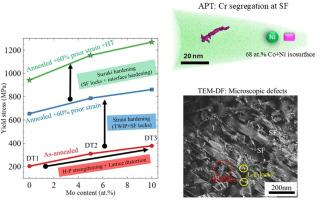通过多长度尺度方法剪裁多主元素合金的机械性能
IF 9.3
1区 材料科学
Q1 MATERIALS SCIENCE, MULTIDISCIPLINARY
引用次数: 0
摘要
本研究采用多长尺度强化方法来定制镍钴铬基多主元素合金(MPEA)的微观结构和机械性能。晶粒细化、晶格严重畸变和堆叠错能(SFE)降低(最高达 10%)使退火后的 MPEA 的屈服强度提高了 85%,而延展性仅降低了 10%。加入钼后,应变硬化率明显增加,这归因于复杂的堆叠断层(SF)相互作用和交叉的促进,同时 Lomer-Cottrell (L-C) 和 Hirth 锁抑制了位错运动,并显著增加了背应力的积累。为了进一步提高屈服强度的极限,通过预应变和随后的 500°C 热处理对 SF 密度进行了细致的控制,从而操纵了铃木偏析现象。预应变和热处理 MPEA 的应力-应变响应显示出明显的 SF 密度和 Mo 浓度依赖性。经过后续热处理的预应变添加钼的 MPEA 的屈服强度提高到了 2.3 GPa 的真实应力,相应的断裂伸长率为 12% 的真实应变。预拉伸过程中形成的 SF 在随后的热处理过程中充当了铬偏析点,这大大改变了 SF 内部的局部 SFE,使其呈现出粗糙的外观,并阻碍了位错动力学。除了传统的强化策略外,加入难熔元素和操纵铃木偏析过程为定制所需的 MPEA 力学性能提供了一条很有前景的途径。本文章由计算机程序翻译,如有差异,请以英文原文为准。


Tailoring mechanical properties of a multi-principal element alloy through a multi-length-scale approach
In this study, a multi-length-scale strengthening approach was used to tailor the microstructure and the mechanical properties of a NiCoCr-based multi-principal element alloy (MPEA). Grain size refinement, severe lattice distortion, and stacking fault energy (SFE) reduction with Mo addition (up to 10 at.%) enhance yield strength by 85 % with only 10 % reduction in ductility in as-annealed MPEAs. A pronounced increase in the strain hardening rate was observed with the addition of Mo, which is ascribed to the promotion of complex stacking fault (SF) interaction and intersection, accompanied by Lomer-Cottrell (L-C) and Hirth locks inhibiting dislocation motion and substantial increase in the accumulation of back stress. To push the limit of the yield strength further, the Suzuki segregation phenomenon was manipulated by a careful control of SF density by pre-straining and a subsequent 500 °C heat treatment. The stress-strain responses of the pre-strained and heat treated MPEAs showed an obvious SF density and Mo concentration dependence. The yield strength of the pre-strained Mo-added MPEAs with subsequent heat treatment was increased up to true stress of 2.3 GPa with a corresponding fracture elongation of 12 % true strain. SFs formed during pre-straining served as Cr segregation sites during subsequent heat treatment, which substantially varies the local SFE within the SF, presenting a roughened landscape and frustrating the dislocation dynamics. Beyond conventional strengthening strategies, incorporation of refractory elements along with the manipulation of Suzuki segregation process provide a promising route in tailoring desired mechanical properties of MPEAs.
求助全文
通过发布文献求助,成功后即可免费获取论文全文。
去求助
来源期刊

Acta Materialia
工程技术-材料科学:综合
CiteScore
16.10
自引率
8.50%
发文量
801
审稿时长
53 days
期刊介绍:
Acta Materialia serves as a platform for publishing full-length, original papers and commissioned overviews that contribute to a profound understanding of the correlation between the processing, structure, and properties of inorganic materials. The journal seeks papers with high impact potential or those that significantly propel the field forward. The scope includes the atomic and molecular arrangements, chemical and electronic structures, and microstructure of materials, focusing on their mechanical or functional behavior across all length scales, including nanostructures.
 求助内容:
求助内容: 应助结果提醒方式:
应助结果提醒方式:


